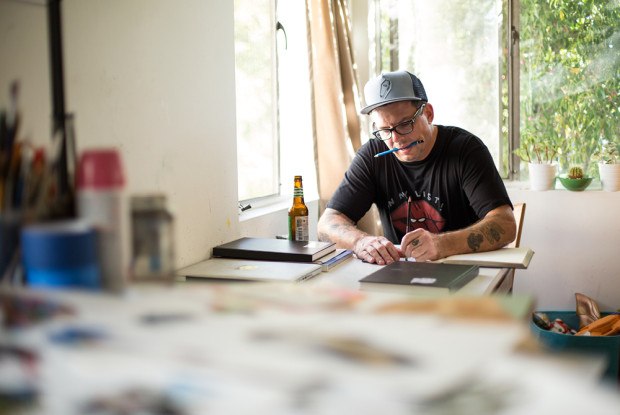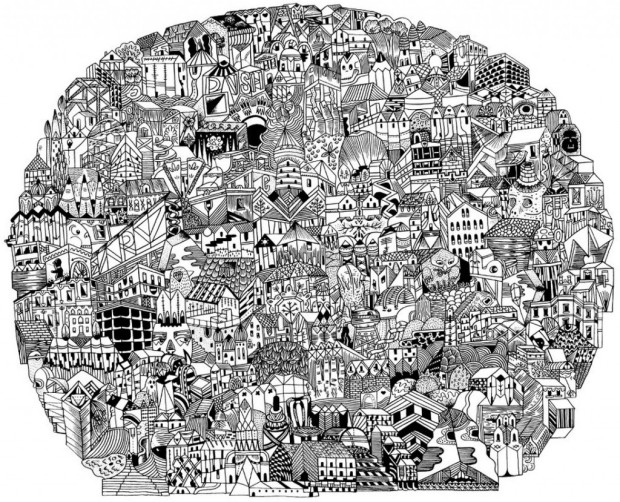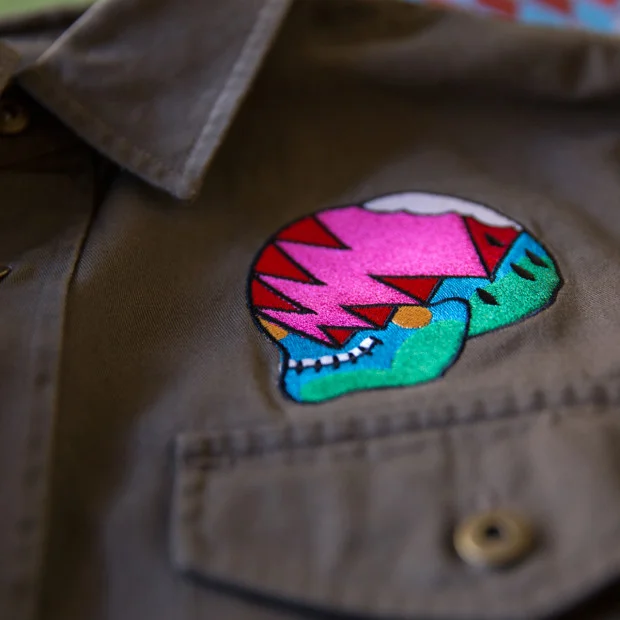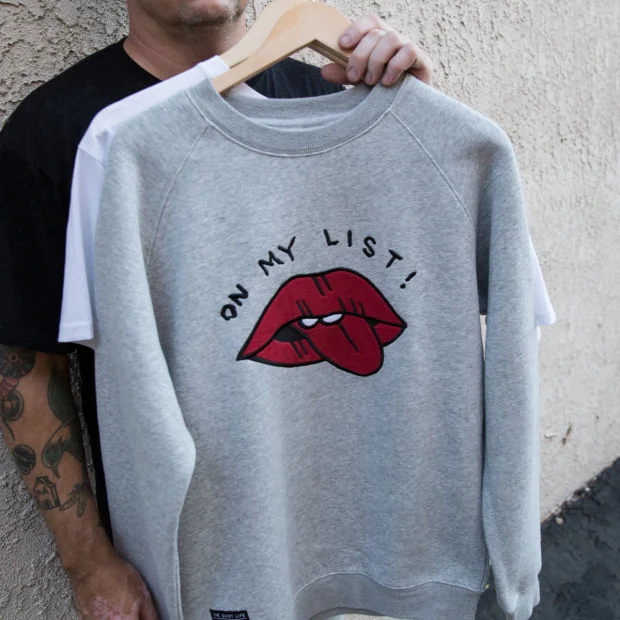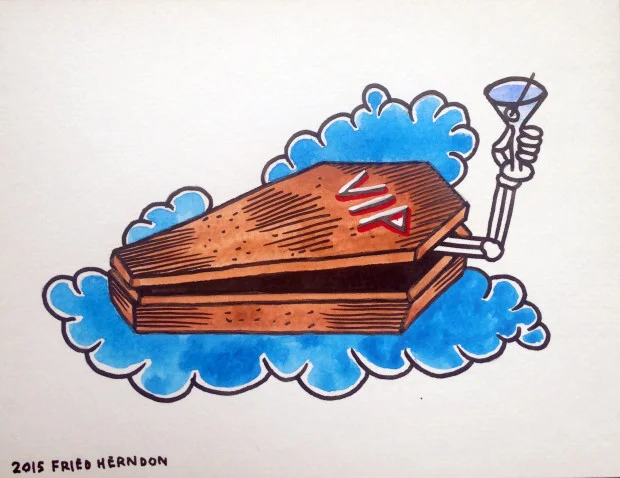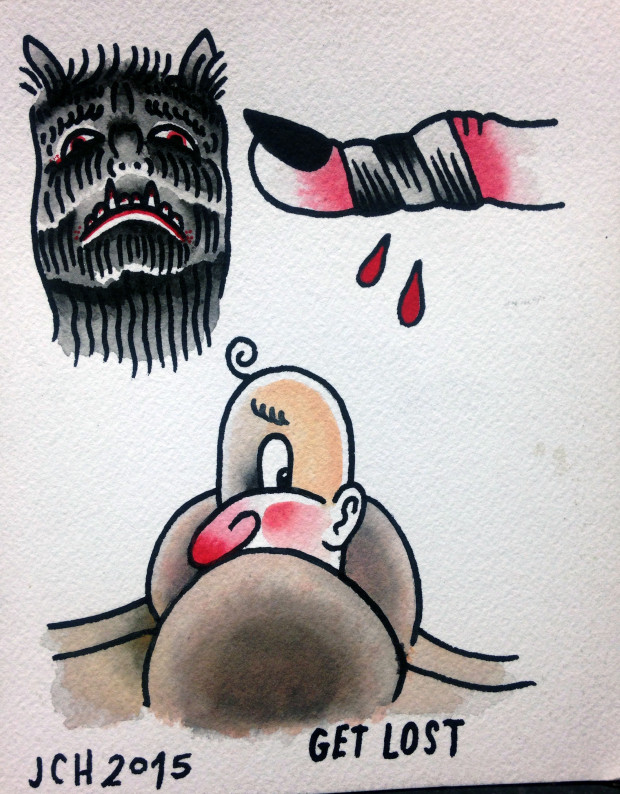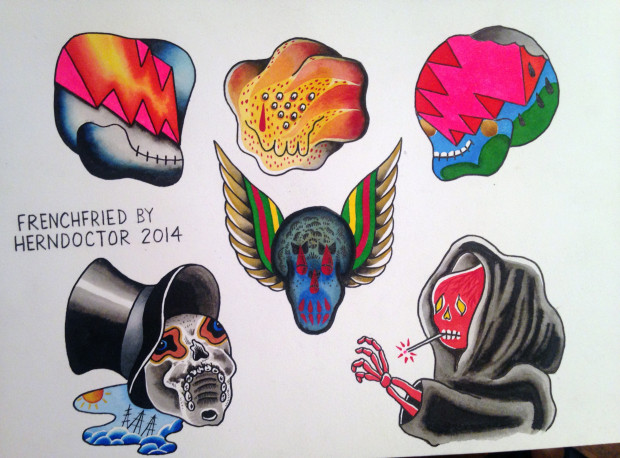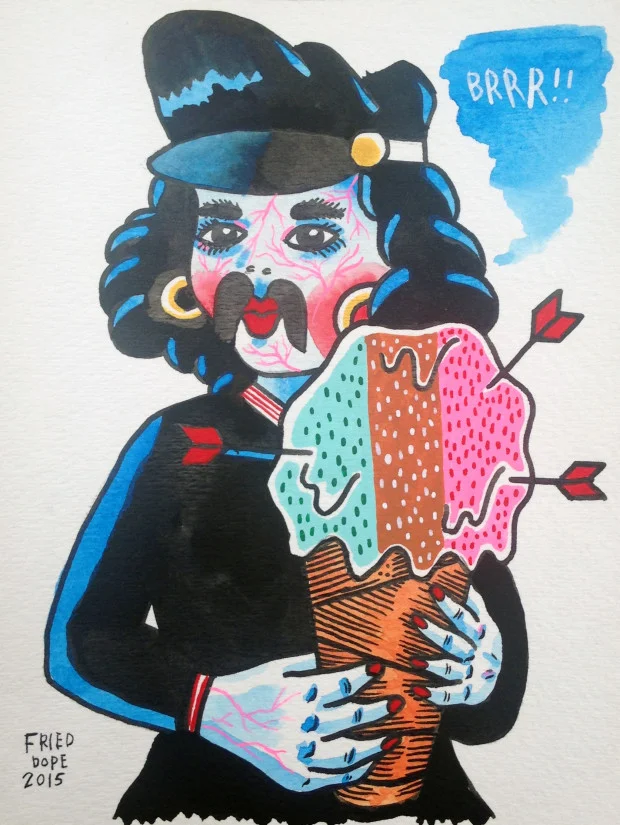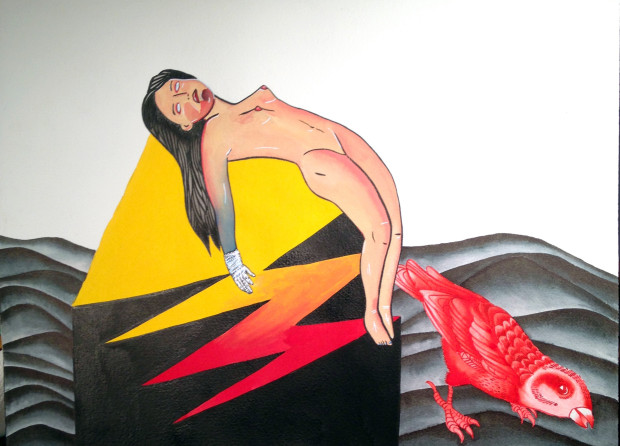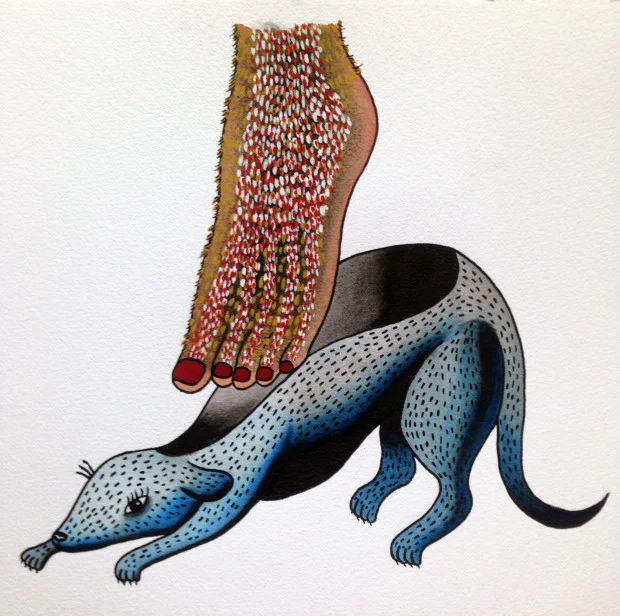Interview/Words by Alex Khatchadourian
Musician and illustrator John Herndon had an unconventional upbringing. After stints of erratic parenting, Herndon's father started a commune with some friends in Boston called the Grateful Union Family Trust. The Family eventually bought a large piece of property in Western North Carolina in 1976, just after the 13-person commune moved from Massachusetts to the mountains of Asheville, NC, and where Herndon spent some of his most formative years. Coming from the impermanent living situation he had sustained in foster care, moving in with the Grateful Union Family was like a dream. It was a communal lifestyle that brought together a wide range of arts and crafts people - weavers, clothing designers, other handmade goods - and an environment that ultimately fostered his creativity and sensibility to pursue an alternative creative lifestyle.
Punk rock and skateboarding served as swathing inspirations for John's artwork - his music and his illustrations - which come from counterculture and a world of teenage rebellion. His artwork exists between anarchic, dark visual references associated with punk and tattoo style illustration and some straight-up abstract work filled with diverse shapes, faces, and buildings rendered harmoniously interconnected on paper. John's illustrations - middle fingers wearing bikinis, coffins inscribed with "VIP" - have graced the bottoms of Antihero skateboard decks, been embroidered on quality crew neck sweatshirts, sweatpants, shirts and hats for The Quiet Life, and inked on countless people's arms and legs as tattoos.
Aped but never bettered, John's artwork boasts dark, psychedelic complexities of which seem to resonate with a much broader cross-section of society than one might think. We caught up with John following the release of his new 'artist capsule' clothing line with The Quiet Life and before he heads out on the road for a tour with his long-time band Tortoise.
You are widely known for playing in bands like Tortoise. Yet, you find yourself creating illustrations, tattoos, and visual art now. Did you always have an interest in this prior to your music?
Yeah, I was always drawing flyers and I did some record cover illustrations, and started making t-shirts for some bands I was in. I always had a hand in drawing, illustrating and painting. I don’t know, now I’m trying to figure out how to balance it all. I feel like my attention is just put towards one avenue and stays there, then moves to something else. It really depends on what’s happening and what requires my focused attention; it’s hard sometimes it makes me feel a little coo-coo bananas. I’m really trying to keep it all together. I wonder sometimes about how people really focus on something and get really masterful at it. I do all these different things similarly or adequately, I don’t know how to do one thing. It helps me to know how to work with different outlets of creativity.
How do you think music and visual work informs or influences each other? Do you think your music plays a large role in what you’re creating visually?
I don’t know particularly. It must be in some way, but I don’t consciously think about it like that. I like things being weird, that’s the underline for me.
Describe your art. If someone were standing there for the first time, how would you introduce a piece? What would you say?
I would try not to say anything. If I was trying to describe what I do I really have no idea, probably punk rock style drawing.
Who were some artists that you admired growing up and have had a visual influence on your work?
When I was younger there was a lot of different stuff I guess I really liked comics. I super love Marc Bell, he’s a comic book artist from Canada, he just does these weird drawings of strange creatures that live underneath your floorboards and things like that. He would do illustrations where there would be a page with lyrics from like a Queen song or something and then he would just create this world around it. I really really loved his stuff. I really like Jack Kirby, who did early Marvel Comics, like Fantastic Four and Spider Man. I really love Paul Klee a painter from Switzerland. He taught at the Bauhaus at the turn of the century. There’s a lot of stuff, just kind of all over the place.
Your larger circular pieces done in ink are particularly intricate. Everything flows together; diverse shapes, faces, and buildings are in harmony and are interconnected, merging a lot of small imagery to create a larger final piece. What is your process like with pieces like this; where do you even start?
Most of the time when I’m doing something like that I try to build it as I go. I don’t make sketches, I just kind of start at the bottom and build up. Then there’s maybe a little bit of bouncing around, but usually I’ll draw a shape - like an oval or circle or whatever shape that I want the buildings or land to be - then I’ll just make shapes around that. I think I was inspired initially by the pen and ink work of Paul Klee. I really liked his way of building shapes that are these vast cityscapes, but they’re flat. He’ll do like a perspective drawing, but everything will be flat. That was my initial concept. Then it kind of morphed into whatever it is that I do now.
There are so many different faces throughout your pieces. Are you consciously hiding these images in your work or does it just happen with your different shapes?
Usually if there are faces in there, I’m conscious of making them, but I kind of put different things in there. I really like the work of Tony Fitzpatrick who makes these drawings that are very dense and so you can look at the same painting a number of times and see different things each time.
You've been skating all of your life. How does skating and skate culture converge with your art work?
I started skateboarding around seven or eight years old it was kind of that first or second wave of popular skateboarding coming into the mainstream. All of my friends were getting skateboards so I got one for Christmas. I don’t even remember what it was; some fiber glass board. It had a Hawaiian flower pattern on the top. I rode that for along time in Boston. When I got into high school, there was a kid there named Kevin who was from Florida and was a skateboarder also. We connected because we were the two kids in the school who were interested in skateboarding. Thrasher had just started to come onto the scene, it was like a large format news print thing at the time. Kevin had built this half pipe in his backyard - one half was built with a framework and stuff and the other half was just built onto it. He had built some quarter pipes in his basement also, and we would always be skating. I loved the way that early on skateboarding, at least for me at that time, the artwork was real cut and paste, like fliers and zines. It was all very appealing to me. My senior year of high school, which was in Los Angeles in 1983 or 1984, I started skating even more out here. It was summer all year round; at that time, I also got to see Circle Jerks and just a ton of punks shows that were always happening.
Do you remember the first skateboard graphic you were really hyped on when you were younger? One that sticks in your mind to this day?
I think the first one was very simple; the red Santa Cruz logo across the bottom of my board. I loved that, just how simple and very visually stimulating it was to me at the time. I was a big fan of all the Dogtown graphics for sure, I never had a Dogtown board - I was always riding different boards - but I always liked looking at the graphics. Then Zorlac Skateboards came out and they had Pushead doing illustrations, those were great.
Tell us about your recent collaboration with the Quiet Life. What was it like working with the company and how did you choose what imagery you wanted to use for the line?
Andy Mueller and Jennifer Pitt who run The Quiet Life were friends from Chicago. Andy was a photographer and filmmaker; he made a short film called Corn Land that was kind of like a vignette of Midwestern skateboard culture, and he asked me to do music for it. That was maybe around 1990 or something, I made some music for his film and he moved to Los Angeles so we kind of fell out of touch.
Then when I moved here we were going to orientation for my kid’s school and Andy and Jennifer were there with their kids. It just so happened that we had landed at the same school. I was doing a lot of painting and had this Wordpress blog where I was putting up images for a while. Andy saw the stuff, liked it, and asked if I would want to maybe do an artist capsule. I went over with maybe 25 drawings. It was funny I gave him one drawing that got put on a t-shirt, but the other drawings he just took some photographs of the drawings. They came up with the ideas of how to translate the ideas to clothing. I was psyched about the embroidery and they are super great pieces. I was really happy with their sense of design and getting it onto certain pieces of clothing not just random fabric.
When you find yourself doodling what do you usually find yourself coming back to all the time?
I do a lot of geometric doodles. Just building up fake towns or something. Skulls are something that I draw all the time. Lately I’ve been trying to draw the human figure because I’m really poor at it. Just trying to draw perspective drawings and sketch a room or something. Also lately it's been lettering, just because I’m bad at it. I try to do stuff that I am weakest at because a sketchbook should be where you should be allowed to draw badly. I try to draw without thinking too much.
What projects do you have coming up?
The new Tortoise record is coming out on the 22nd of January. We will be gearing up to do a lot of touring. We have some shows at the end of January, then pretty much from February to September we will be on and off the road.
Where does the moniker "French Fried Eyeballs" come from?
That's from a kid's song that I used to sing with friends, that somehow stuck with me. It goes:
Great green globs of greasy, grimy gopher guts
Mutilated monkey meat
Dirty little birdie feet
French fried eyeballs swimming in a pool of blood
And I forgot my spoon.
For more from John Herndon head to www.agrapedope.com.

